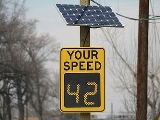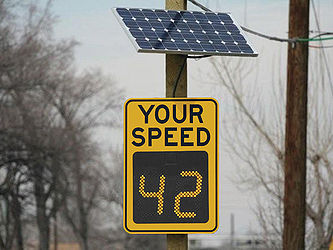
Radar speed sign
Encyclopedia

LEd
LEd is a TeX/LaTeX editing software working under Microsoft Windows. It is a freeware product....
s, that displays vehicle speed as motorists approach. The purpose of radar speed signs is to slow cars down by making drivers aware when they are driving at unsafe speeds. They are used as a traffic calming
Traffic calming
Traffic calming is intended to slow or reduce motor-vehicle traffic in order to improve the living conditions for residents as well as to improve safety for pedestrians and cyclists. Urban planners and traffic engineers have many strategies for traffic calming...
device in addition to or instead of physical devices such as speed humps, speed cushions, speed tables, and speed bumps.
Usage
Radar speed signs are often used in school zoneSchool zone
A school zone refers to an area on a street near a school or near a crosswalk leading to a school that has a likely presence of younger pedestrians. School zones generally have a reduced speed limit during certain hours.-Fines:...
s, sometimes in conjunction with Safe Routes to School programs, in construction zones, or on busy residential roads. Some college and corporate campuses use radar speed signs to slow traffic as well. Many plants are using these signs to monitor forklifts and other type trucks. There are steps to placing a radar speed sign.
Speed display signs are sometimes used in conjunction with physical traffic calming
Traffic calming
Traffic calming is intended to slow or reduce motor-vehicle traffic in order to improve the living conditions for residents as well as to improve safety for pedestrians and cyclists. Urban planners and traffic engineers have many strategies for traffic calming...
solutions. They are also used on streets that cities do not want to put physical measures on either because of snow concerns or traffic volume. Often, cities will use these signs to test streets to determine the need for further traffic calming.
Features and Sign Types
Signs are available in a range of costs with a variety of different features. Manufacturers of radar speed signs abound, ranging in style and features from a basic inexpensive sign to more sophisticated signs with myriad features to help analyze data and improve results. Pole mounted signs that combine speed display with variable message capability are often used in school zones, eliminating the trailer's "footprint".Standard signs have stationary block letters that display the words "your speed". More advanced models include variable messages such as Your Speed, Speed Limit, and Slow Down, which can be programmed based on motorist speed.
Many manufacturers offer optional solar power, which allows the signs to be powered via solar energy with rechargeable batteries included for nighttime operation. Many users (especially in Northern climates) have reported problems with solar powered signs failing to work during winter months, and with their internal batteries failing prematurely. However, newer proprietary power efficient methods are available as well as cold weather batteries.
Some of the features offered on the higher end signs include focused viewing systems to avoid distractions for motorists in other lanes, vehicle data collection, programmable software that allows you to determine sign behavior, and/or access via portable devices such as Bluetooth
Bluetooth
Bluetooth is a proprietary open wireless technology standard for exchanging data over short distances from fixed and mobile devices, creating personal area networks with high levels of security...
or PDAs
Personal digital assistant
A personal digital assistant , also known as a palmtop computer, or personal data assistant, is a mobile device that functions as a personal information manager. Current PDAs often have the ability to connect to the Internet...
. Many signs offer tampering and vandalism prevention measures built in to the signs, such as Lexan and BashPlates. Some signs offer a flashing light to warn motorists who exceed a designated speed. However, many state, county and city traffic engineers in the USA specify only signs that meet the federal guidelines called MUTCD (Manual on Uniform Traffic Control Devices) which, due to safety reasons, eliminate certain distracting features like strobe lights and certain color messages. A Vermont state guideline is very specific and eliminates many features. See more about MUTCD below.
Effectiveness
Studies conducted both in the UK and in the US have found radar speed signs to effectively slow traffic down. Although the overall speed reductions are generally less than those resulting from physical measures, the signs have the greatest effect on those drivers that are exceeding the posted speed.One sample study conducted in Bellevue, Washington found that radar speed signs resulted in average speed reductions of from 1-5 mph, although some locations resulted in changes upwards of 5.5 mph. In spite of the small average speed reduction, the city considers the signs to be successful because they have resulted in a dramatic reduction in the speed of those vehicles that were traveling in excess of the limit, while not interfering with the progress of the majority of traffic that is already traveling at or below the speed limit.
The signs were most effective on streets where vehicles were driving more than 10 mph above the posted speed limit. In the Bellevue study, streets where signs were installed continued to experience speed reductions even two years after the signs were installed.
Instead of slowing, some speed up to see how high they can get the sign to read. To avoid this some signs simply flash a speeding light instead of displaying the speed. Adding enforcement downstream also increases effectiveness.
Federal Standards
The MUTCD (Manual on Uniform Traffic Control Devices), a document issued by the Federal Highway Administration (FHWA) of the United States Department of Transportation (USDOT), has specified standards regarding sign size and letter height for Speed Limit Signs (an R2-1 in the parlance) under Section 2B.13. This is the only section of the current revision of the MUTCD to mention the use of a radar speed sign and refers to them as “changeable message signs”, a term normally associated with work zone safety and the like. When the current MUTCD was issued (2003, rev. 2) this aspect of the market was in its infancy.Section 2B.13 (excerpt)
“A changeable message sign that changes the speed limit for traffic and ambient conditions may be installed provided that the appropriate speed limit is shown at the proper times.
A changeable message sign that displays to approaching drivers the speed at which they are traveling may be installed in conjunction with a Speed Limit sign.
Guidance:
If a changeable message sign displaying approach speeds is installed, the legend YOUR SPEED XX km/h (MPH) or such similar legend should be shown. The color of the changeable message legend should be a yellow legend on a black background or the reverse of these colors.”
The first paragraph allows for the use of VSL Signs (Variable Speed Limit signs), the second for use of a Speed Feedback Sign. The third is “Guidance”, not regulation, concerning the content and color of the “legend”, typically the static signage surrounding the electronic display.
Two other states have been much more specific in their directive regarding Speed Feedback Signs, California and Minnesota. California’s most recent comments were somewhat more specific as to what they expected. In it they expressed specifics regarding color of the numerals, some technical specifics regarding the LEDs used and expressly prohibit the signs from being used for any VSL purpose, which several signs on the market do. They also call for a White on Black plaque rarely if ever found in the market. White on black is usually reserved for night time speed limit signs. In addition the document offers guidance on character shape, eschewing the common 7-segment style for a more graphic character resembling the fonts (D or E Series Highway Fonts) used on R2-1 signs.
“California MUTCD Page 2B-13
(FHWA’s MUTCD 2003 Revision 1, as amended for use in California)
Vehicle Speed Feedback Signs
Option:
A Vehicle Speed Feedback sign that displays to approaching drivers the speed at which they are traveling may be installed in conjunction with a Speed Limit (R2-1) sign.
Standard:
If a Vehicle Speed Feedback sign displaying approach speeds is installed, the legend shall be YOUR SPEED XX.
The numerals displaying the speed shall be white, yellow, yellow-green or amber color on black background.
When activated, lights shall be steady-burn conforming to the provisions of CVC Sections 21466 and 21466.5.
Vehicle Speed Feedback signs shall not alternatively be operated as variable speed limit signs.
Guidance:
To the degree practical, numerals for displaying approach speeds should be similar font and size as numerals on the corresponding Speed Limit (R2-1) sign.
Option:
When used, the Vehicle Speed Feedback sign may be mounted on either a separate support or on the same support as the Speed Limit (R2-1) sign.
In lieu of lights, legend may be retro-reflective film for flip-disk systems.
The legend YOUR SPEED may be white on black plaque located above the changeable speed display.
Support:
Driver comprehension may improve when the Vehicle Speed Feedback Sign is mounted on the same support below the Speed Limit (R2-1) sign.
Vehicle Speed Feedback Signs are appropriate for use with advisory speed signs and with temporary signs in temporary traffic control zones.”
In Minnesota’s case their Department of Transportation got very specific. Too exhaustive to repeat here, it nevertheless addresses specific static sign color based on application, flash rates and activation speeds for violator alerts etc. In addition, a Minimum Product Specification is attached to the document.
It is widely believed in the industry that the new revision of the Federal MUTCD will much more specifically address these devices and will most likely grandfather in non-compliant existing signs for some reasonable period of time.

